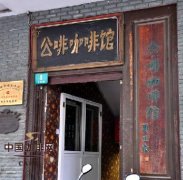Zheng Yongqing's relationship with the Cafe the Culture of the Cafe

In Japan, cafes also became popular among intellectuals and then among the general public by virtue of the cultural movement. On April 13, 1888, Japan's first coffee shop opened twice in Tokyo's Ueno Nishimen-cho (another said that the earliest coffee shop in Japan was the "washing Pavilion" opened in Tokyo's Nippon Bridge in 1886). The owner, Zheng Yongqing, also has a special relationship with China. He is the adopted son of Zheng Yongning, a descendant of Tian Chuan Qi Zuo Weimen, a younger brother of Zheng Chenggong. Born in Nagasaki in 1859, he studied at Yale University in the United States and is proficient in Chinese, English, French and Japanese. As a senior intellectual, Zheng Yongqing pursues to promote coffee as a kind of literati spirit. Taking the teahouse acceptable to the Japanese literati at that time as a signboard, he named his coffee shop "can you teahouse" and sold Westerners' coffee in it. The Japanese pronunciation of "can" is similar to that of "coffee", and later it even became a fixed translation of "coffee" in Japanese. As a beverage first liked by cultural people, coffee had a lot of literary translation at that time, including "can not", "bone non -", "bone happiness", "Jiaxi" and so on. Some people have named it "Tang Tea", "Xiangtang" and so on. Zheng Yung-ching also complied with this trend and put all kinds of books, newspapers and periodicals in his own coffee shop, even the four treasures of the study, in short, he strived to integrate the aroma of books and coffee. At that time, Japanese intellectuals also had many interesting hobbies when they went to cafes. For example, some people would bring geisha to cafes to accompany reading, while others, like Mr. Lu Xun, showed up frequently in cafes but never drank a cup of coffee. Because in the eyes of people at that time, it was important to sit in front of the high-back seat of the cafe, with a popular literary publication spread out on the table, and it didn't matter whether it was coffee, green tea or even boiled water.
Zheng Yongqing's "can not teahouse" eventually closed down quietly after four years of opening because of its high style, poor management and successive years of deficit. However, the coffee culture craze set off by "whether the teahouse" has led to the emergence of successors. In 1890, the Gem Coffee Shop in Asakusa, Tokyo, officially opened. In 1909, Caf é Paulista, the first generation of Brazilian immigrant Mizuno in Japan, got free coffee bean sponsorship from Brazil, thus opening chain stores all over Japan. The Tokyo branch, which was founded in 1911, still stands opposite the toy store of the Badingmu Museum in Ginza. At that time, the advertising slogan of this coffee shop was "hot coffee as black as ghosts, sweet as love, and hot as hell." and the coffee here is cheap and good, only 5 cents per cup, plus 5 cents, and you can get a doughnut. So it attracted many young scholars at that time and college students from nearby Keio University to stop here. It is said that Akita Yuki, a member of the Esperanto Popularization Society at that time, often bought only one cup of coffee but occupied 10 seats, and held a seminar here every week, which was praised as an example of being stingy.
When it first opened, the Old S ã o Paulo Cafe had a hostess department on the second floor. In 1911, Aoki, a women's magazine founded by Hirazuka Thunderbird, often held editorial meetings in the concierge department, where a group of fashionable and famous women gathered to talk and sat all afternoon. "Green Shock" is an 18th century British "Bluestockings" female literati, and blue socks later became a symbol of new women in Japan. Although today's "Old S ã o Paulo Cafe" has cancelled the hostess department, female guests in blue socks are still given special treatment and coffee money can be waived. I also heard that once Lennon and Yoko Ono stayed in Ginza and came here for three consecutive nights to order the shop's signature Paulista Old to drink. This kind of mixed coffee has been on the menu since its inception. Yoko Ono can be regarded as a new woman. I wonder if she went there wearing blue socks at that time.
Important Notice :
前街咖啡 FrontStreet Coffee has moved to new addredd:
FrontStreet Coffee Address: 315,Donghua East Road,GuangZhou
Tel:020 38364473
- Prev

The connection between celebrities and Coffee Lu Xun and the Coffee Cafe
Although he did not enjoy the store's signature drink, the public coffee cafe is still famous for Lu Xun's many trips. Gongfen was located near the tram terminal on North Sichuan Road in Shanghai at that time, opposite the Neishan Bookstore. It must not have been the earliest coffee shop in Shanghai, nor was it the best coffee shop in Shanghai at that time. But because the Chinese left-wing Writers' Union became the era that later generations said.
- Next

Coffee shops are closely related to French Literature and Coffee Culture
If you live in Paris for a while, you will find that the French like cafes. There are many cafes in Paris that are famous for their literature and art. Some critics even say that it is the cafe that has created the history of modern French literature. This may be an exaggeration, but the inextricable bond between cafes and French literature over the centuries is obvious to all. Alexis, who won the Gongol Prize, the highest prize in French literature this year.
Related
- How did the Salvadoran coffee industry develop in Central America?
- What exactly does the golden cup extraction of coffee mean?
- The Origin of Coffee flower
- [2023 Starbucks World Earth Day] there are more meaningful things besides free Starbucks coffee!
- What kind of coffee is there in Spain? 9 Flavors of Spanish Coffee
- Aromatic African coffee| Kenya's coffee culture and historical production area
- Liberica Coffee Bean knowledge: the characteristics of Liberian Coffee beans of the three original species of Coffee beans
- The origin and formula of Spanish latte introduces the taste characteristics of Bombon coffee in Valencia, Spain.
- How to adjust the solution of over-extracted coffee
- What is the tasting period of coffee beans? What is the period of coffee and beans? How should coffee wake up and raise beans?

